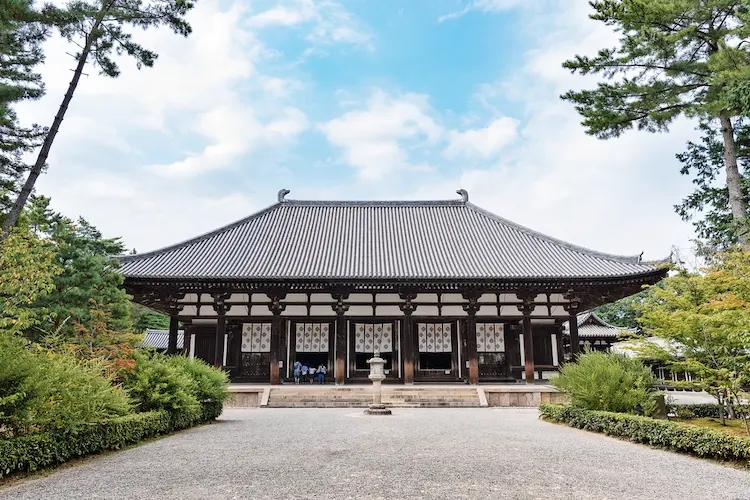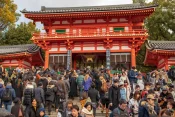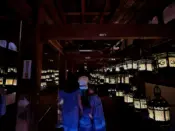Discover the Sacred Toshodaiji Temple Ominugui Ceremony – A Unique Winter Tradition in Nara
Toshodaiji Temple, one of Nara’s most significant historical landmarks, hosts an annual event that truly captures the spirit of renewal and reverence. Known as the Ominugui Ceremony, this unique tradition takes place every year on December 15th, inviting visitors to witness the ritual cleansing of sacred Buddhist statues in preparation for the new year. This article explores the history, meaning, and charm of this incredible event that continues to captivate both locals and tourists alike.
1. What is Ominugui?
The Ominugui Ceremony is a special ritual held at Toshodaiji Temple to purify the temple’s cherished Buddhist statues. On December 15th, monks gather to clear away a year’s worth of dust and grime that has accumulated on the statues, thus preparing for the arrival of the new year with a sense of purity and renewal. The sight of monks using long bamboo poles with Japanese washi paper attached to their ends to gently clean these statues is both a solemn and enchanting scene. This act of devotion embodies the spirit of gratitude and respect for these sacred artifacts, which have stood in the temple for centuries.
2. Flow of the Ceremony
The ceremony begins with the monks conducting a Buddhist service, chanting sutras to invoke blessings and guidance for the upcoming year. Following the service, they take up the long bamboo poles with soft washi brushes to carefully dust off the statues, ensuring every corner is cleaned and honored. The attendees—locals and tourists alike—stand in quiet reverence, many with their hands clasped in prayer, as they witness this act of deep spirituality. The atmosphere is filled with a sense of serenity, making it a truly moving experience.
3. Visitor Impressions
Many visitors to the Ominugui Ceremony describe the experience as spiritually cleansing. Watching the monks meticulously clean each statue with such dedication allows attendees to reflect on their own lives and renew their own sense of purpose. One visitor mentioned, “Seeing the monks clean the sacred statues made me feel as though I, too, was being spiritually refreshed.” The quiet yet profound nature of the ceremony brings an overwhelming sense of peace, leaving many attendees deeply touched.
4. The Significance of the Ceremony
The Ominugui Ceremony is not merely about physical cleaning—it holds a deep symbolic meaning. By purifying the Buddhist statues, the monks are praying for a peaceful and prosperous new year. This tradition is a reminder of the importance of letting go of the past year’s burdens and welcoming the new year with a renewed spirit. The event serves as a bridge between the past and future, combining ritual purity with spiritual hope for everyone who participates or observes.
5. Location Details
- Where: The Ominugui Ceremony takes place at the Main Hall (Kondo) of Toshodaiji Temple, a renowned temple located in Nara City.
- When: Annually on December 15th, starting from 9:00 AM.
- How to Attend: Visitors are free to attend and observe the ceremony. It’s an open invitation to experience one of Nara’s cherished cultural traditions firsthand.
- Flow of Events: The ceremony starts with a Buddhist service, followed by the cleansing of the statues.
6. Historical Background of Toshodaiji Temple
- Founder: Toshodaiji Temple was founded by Jianzhen (Ganjin), a Chinese monk who traveled to Japan to spread the teachings of Buddhist precepts.
- Year of Establishment: The temple was established in 759 AD, making it one of Japan’s oldest and most historically significant religious sites.
- Purpose: Originally, the temple served as a place of study for monks to learn the strict moral discipline and precepts of Buddhism.
- Cultural Heritage: Today, Toshodaiji is part of the UNESCO World Heritage site “Historic Monuments of Ancient Nara”, recognized for its important role in the development of Japanese Buddhism.
- Historical Significance: Toshodaiji Temple has played a key role in the cultural and religious history of Japan, representing an essential connection between Chinese and Japanese Buddhist traditions.
7. Access Information
- Address: 13-46 Gojō-chō, Nara City, Nara Prefecture, 630-8032.
- Nearest Station: A 10-minute walk from Kintetsu Nishinokyo Station.
- By Bus: Take the #78 bus from JR Nara Station or Kintetsu Nara Station to “Nara Prefecture General Medical Center,” then walk to Toshodaiji Temple.
- Parking: The temple offers parking for 150 vehicles, with separate rates for buses and cars.
- Accessibility: Toshodaiji Temple is wheelchair accessible, with ramps and multi-purpose restrooms available to accommodate all visitors.
8. Admission Fees
- Adults/University Students: 1,000 yen.
- High School and Middle School Students: 400 yen.
- Elementary School Students: 200 yen.
- Group Discount: Groups of 30 or more receive a discounted rate of 800 yen for adults/university students.
- Disability Discount: Half price for individuals with disabilities (including one caregiver).
Conclusion
The Ominugui Ceremony at Toshodaiji Temple is a profound reminder of the value of renewal and reverence. It provides an incredible opportunity for visitors to witness a beautiful and solemn ritual that has been part of Nara’s cultural fabric for centuries. Whether you’re interested in Japanese culture, history, or simply seeking a spiritually uplifting experience, attending the Toshodaiji Temple Ominugui is a perfect way to connect with Japan’s heritage and embrace the spirit of the new year. If you find yourself in Nara in mid-December, don’t miss this unique and inspiring tradition.









